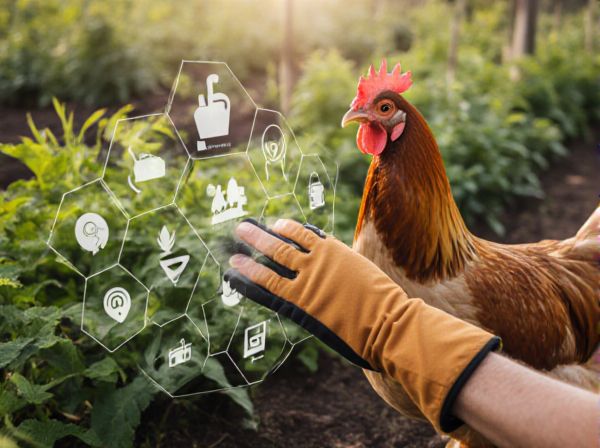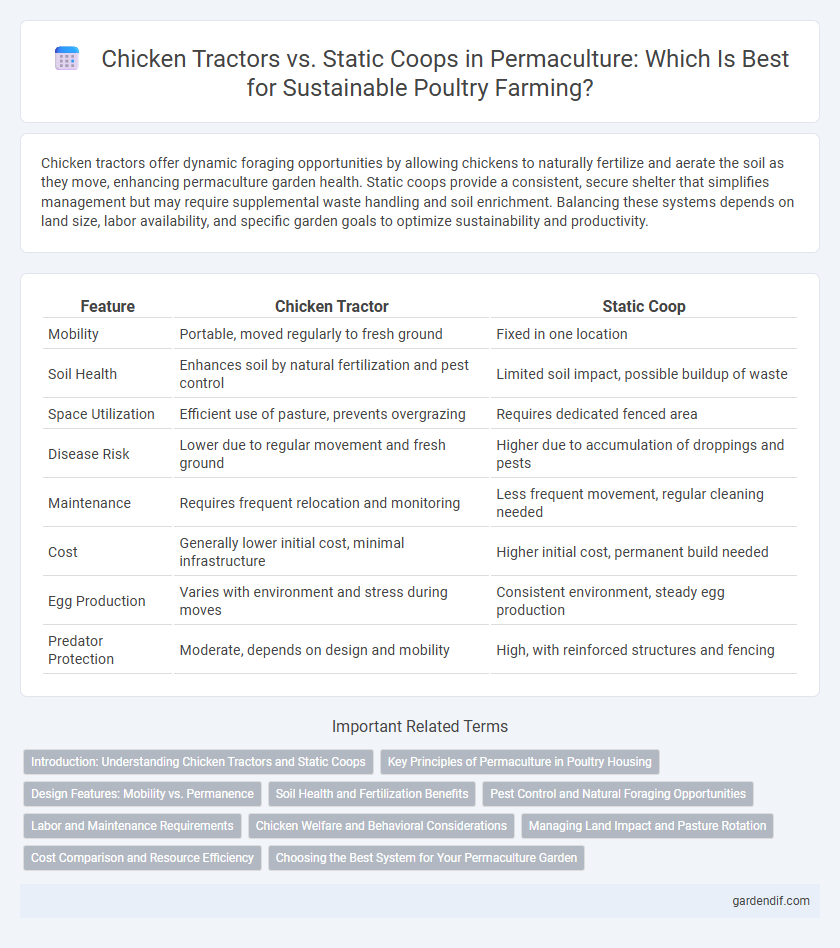
Chicken Tractors vs Static Coops Illustration
Chicken tractors offer dynamic foraging opportunities by allowing chickens to naturally fertilize and aerate the soil as they move, enhancing permaculture garden health. Static coops provide a consistent, secure shelter that simplifies management but may require supplemental waste handling and soil enrichment. Balancing these systems depends on land size, labor availability, and specific garden goals to optimize sustainability and productivity.
Table of Comparison
| Feature | Chicken Tractor | Static Coop |
|---|---|---|
| Mobility | Portable, moved regularly to fresh ground | Fixed in one location |
| Soil Health | Enhances soil by natural fertilization and pest control | Limited soil impact, possible buildup of waste |
| Space Utilization | Efficient use of pasture, prevents overgrazing | Requires dedicated fenced area |
| Disease Risk | Lower due to regular movement and fresh ground | Higher due to accumulation of droppings and pests |
| Maintenance | Requires frequent relocation and monitoring | Less frequent movement, regular cleaning needed |
| Cost | Generally lower initial cost, minimal infrastructure | Higher initial cost, permanent build needed |
| Egg Production | Varies with environment and stress during moves | Consistent environment, steady egg production |
| Predator Protection | Moderate, depends on design and mobility | High, with reinforced structures and fencing |
Introduction: Understanding Chicken Tractors and Static Coops
Chicken tractors are mobile poultry shelters that allow chickens to forage on fresh ground while protecting them from predators, enhancing soil health through natural fertilization. Static coops are fixed enclosures offering permanent shelter and nesting areas, simplifying management but limiting foraging space and natural behaviors. Understanding the differences in mobility, foraging opportunity, and ecosystem impact is essential for selecting the best poultry housing in permaculture systems.
Key Principles of Permaculture in Poultry Housing
Chicken tractors exemplify permaculture principles by enabling rotational grazing, which improves soil fertility and reduces pest cycles through natural manure distribution and vegetation management. Static coops focus on stability and protection, integrating with perennial plant guilds to create sustainable microhabitats that conserve resources and provide constant shelter. Both systems emphasize energy efficiency, closed nutrient loops, and enhancing biodiversity, central to permaculture ethics of care for earth, people, and future generations.
Design Features: Mobility vs. Permanence
Chicken tractors offer mobility with lightweight frames and wheels, enabling easy relocation to fresh ground for natural pest control and soil fertilization, enhancing permaculture cycles. Static coops feature permanent foundations with robust materials for long-term shelter, nesting, and protection, ideal for stable, predator-resistant environments. Mobility in chicken tractors supports rotational grazing and land restoration, while permanence in static coops ensures durable housing and consistent climate control.
Soil Health and Fertilization Benefits
Chicken tractors enhance soil health by allowing hens to naturally till and fertilize rotating plots, promoting nutrient cycling and reducing soil compaction. Static coops concentrate waste in one area, which can lead to nutrient buildup and potential soil degradation without appropriate management practices. Integrating movable chicken tractors supports balanced fertilization and fosters improved soil biodiversity vital for permaculture systems.
Pest Control and Natural Foraging Opportunities
Chicken tractors offer superior pest control by allowing chickens to graze on fresh ground, effectively reducing insect populations and soil pests in a rotational manner. Static coops limit chickens to a fixed area, often resulting in over-foraging and pest buildup, which can lead to increased parasite risks and soil depletion. By promoting natural foraging opportunities, chicken tractors enhance soil fertility and biodiversity, aligning with permaculture principles for sustainable pest management.
Labor and Maintenance Requirements
Chicken tractors demand more frequent labor due to their mobility, requiring daily movement to fresh ground, which promotes soil health and reduces parasite buildup. Static coops have lower daily labor but necessitate regular deep cleaning and maintenance to manage waste accumulation and prevent disease. Efficient permaculture systems balance the active management of chicken tractors with the low-maintenance stability of static coops to optimize productivity and animal welfare.
Chicken Welfare and Behavioral Considerations
Chicken tractors enhance chicken welfare by providing continuous access to fresh forage, promoting natural behaviors like scratching, pecking, and dust bathing, which reduce stress and improve overall health. Static coops limit these behaviors due to confined space but offer consistent shelter and protection from predators and harsh weather conditions. Balancing mobility and security in poultry housing supports optimal behavioral expression and well-being in permaculture systems.
Managing Land Impact and Pasture Rotation
Chicken tractors offer dynamic land management by allowing chickens to forage on fresh pasture regularly, which promotes natural fertilization and reduces the risk of overgrazing. Static coops concentrate chicken activity in a fixed area, often leading to soil compaction, nutrient build-up, and vegetation loss unless carefully managed with systematic pasture rotation or supplemental land rest periods. Efficient pasture rotation with chicken tractors supports soil health, increases biodiversity, and enhances sustainable land use in permaculture systems.
Cost Comparison and Resource Efficiency
Chicken tractors offer lower initial costs and enhanced resource efficiency by allowing chickens to forage naturally, reducing feed expenses and improving soil health through waste integration. Static coops involve higher upfront investments for permanent structures and require more input for waste management, increasing maintenance costs over time. The mobility of chicken tractors optimizes pasture utilization, making them more cost-effective and sustainable for small-scale permaculture setups.
Choosing the Best System for Your Permaculture Garden
Chicken tractors offer dynamic soil enrichment and pest control by allowing free-range foraging in rotating garden plots, enhancing nitrogen fixation and organic matter. Static coops provide stable shelter and protection, requiring manual waste management but simplifying flock monitoring and biosecurity. Selecting the best system depends on garden size, soil health goals, and integration with plant guilds to maximize regenerative benefits in permaculture design.
Chicken Tractors vs Static Coops Infographic

 gardendif.com
gardendif.com